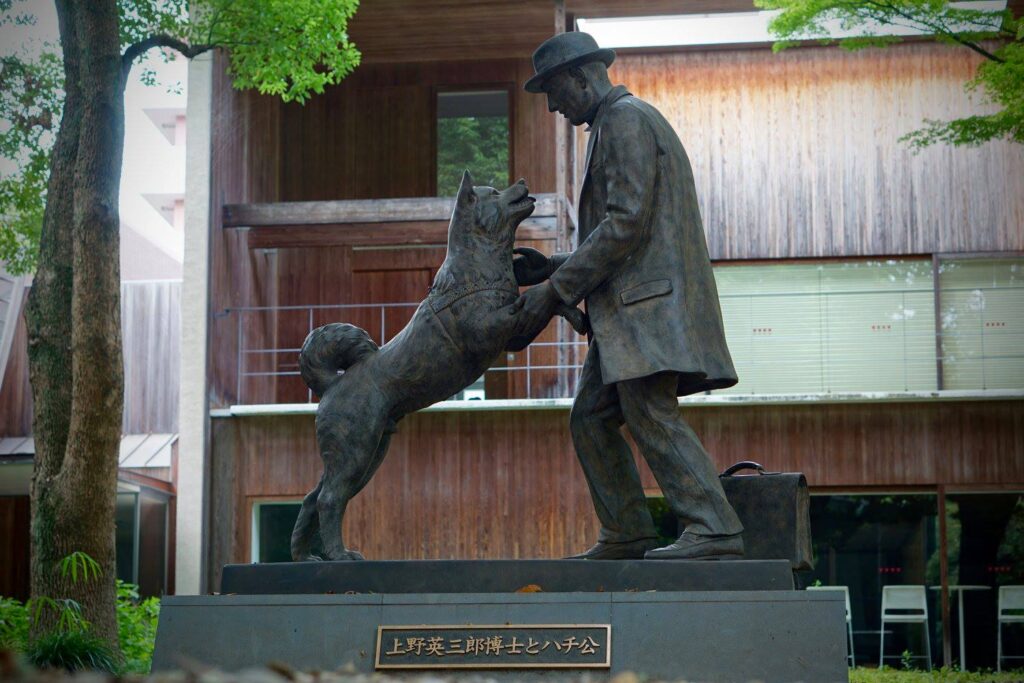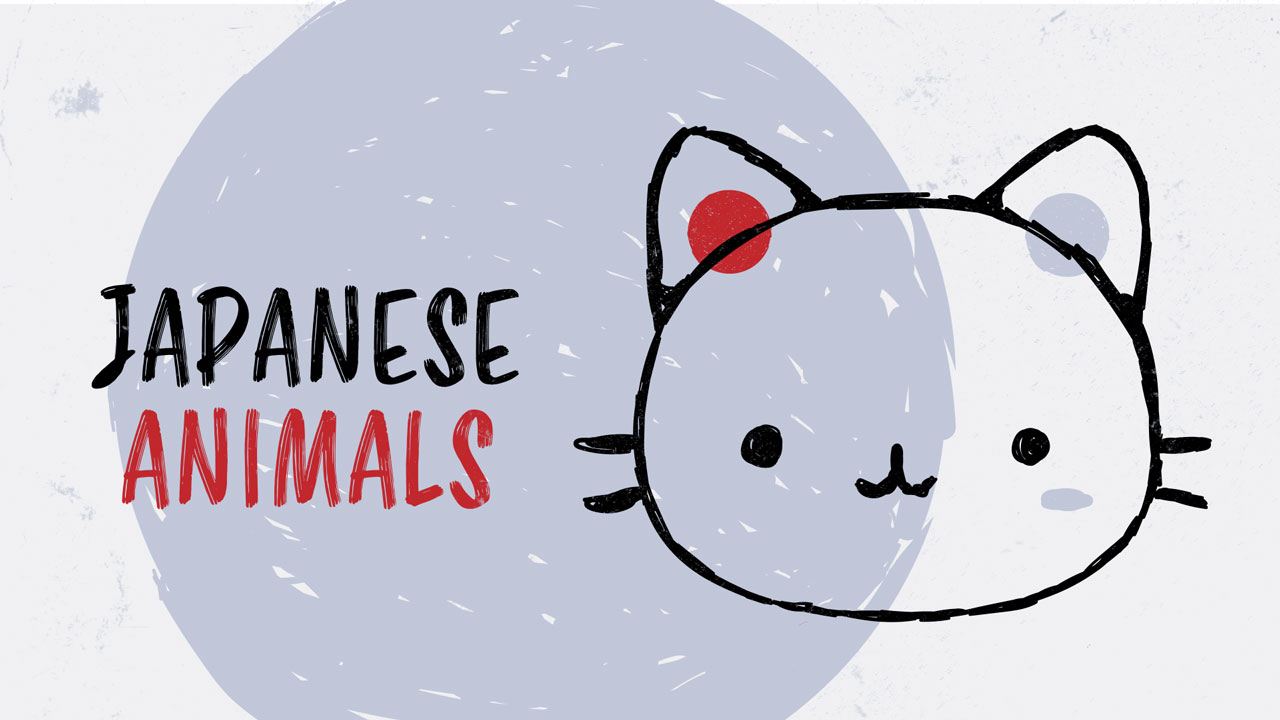Talk About Japanese Animals: Essential Vocabulary about Animals in Japanese
It’s not enough to be able to talk about people in Japanese – we need to learn how to talk about animals, too! What animals are you likely going to find in Japan? What do animals sound like in Japanese – in other words, what are some animal-related onomatopoeia? And how are animals connected to Japanese culture? Keep reading to find out!
First of all, in Japanese, the word for “animal” or “animals” is 動物 (doubutsu).
You’ll run into all sorts of animals – in person or in conversation! In cities and towns, you’ll most commonly encounter animals at home as pets (or pests), in zoos, or in businesses. (You may have heard of cat cafes – but did you know there are cafes with hedgehogs, owls, and more?) If you’re in rural areas, you might come across all sorts of farm animals and wild animals. Here are some lists of animals you might find in all of these situations.
Table of contents
Pets in Japanese
Learning about how to talk about pets is the best starting point for learning animals in Japanese. Who can resist talking about their furry (or feathery) best friend?
The word for “pet” in Japanese is ペット (petto). As you might have guessed, it comes from the English word!
While pets and animal companions have long been a part of Japanese culture, Japan has experienced a “pet boom” since the early 2000s. Especially as fewer people have children in Japan, more people are choosing to take care of animals for companionship. Many elderly people in Japan also enjoy keeping animals as pets.
Here are some animals you’ll commonly find as pets in Japan:
- dog – 犬 (inu)
- cat – 猫 (neko)
- bird – 鳥 (tori)
- hamster – ハムスター (hamusutaa)
- mouse – なずみ (nezumi)
- rabbit – うさぎ (usagi)
- ferret – フェレット (feretto)
- hedgehog – ハリネズミ (harinezumi)
- fish – 魚 (sakana)
- koi fish (carp) – 鯉 (koi)
- rhinoceros beetle – カブトムシ (kabutomushi)
- snake – ヘビ (hebi)
- turtle – カメ (kame)
Japanese living spaces are often quite small, especially in cities. Because of this, Japanese people often keep pets that can also live in compact spaces and are fairly easy to clean.
There are many varieties of native Japanese dogs. The most common are the shiba inu (柴犬, shibaken) and the Akita inu (秋田犬, akitaken). Thanks to the internet, they are now popular all over the world!
You may have also heard the story of Hachiko (ハチ公), the Akita dog who loyally waited for his owner at the station every day, even after he died. There is a famous statue of Hachiko outside of Shibuya Station and a wonderful statue of Hachiko reuniting with his owner at the University of Tokyo.

Hachiko being reunited with his owner, Dr. Ueno, at the University of Tokyo campus
Small dog breeds such as chihuahuas (チワワ, chiwawa), toy poodles (トイプードル, toi puudoru), and dachshunds (ダックスフンド, dakkusufundo) are also very popular.
However, not all pets are animals in Japan! Scientists and companies have been developing robotic pets, such as the robotic dog AIBO. Another notable robot pet is the baby harp seal PARO, which is being developed to provide emotional support for people in hospitals and nursing homes.
You may also have heard of cat cafes (猫カフェ, neko kafe) in Japan. At a cat cafe, you can pay a fee to enter and pet or play with the cats in the shop, and also have a small meal or a drink. Besides cat cafes, you might also find owl (フクロウ, fukurou) cafes, hedgehog (ハリネズミ, harinezumi) cafes, rabbit (うさぎ, usagi) cafes, dog (犬, inu) cafes, micro pig (マイクロブタ, maikuro buta) cafes, and more.
These are very popular because many apartments do not allow tenants to keep animals. Or people might not feel ready for the responsibility of caring for a pet.
However, keep in mind that animal rights are not as protected in Japan as they are in some other high-income countries. Therefore, some animal cafes operate more ethically than others. Some might have environments that are incredibly stressful for the animals, but others take very good care of them. Some cat cafes even take in abandoned cats and may let you adopt them! If these are issues close to your heart, it is a good idea to research the animal and cafe policies beforehand!
Speaking of which, animal shelters are called 動物保護施設 (doubutsu hogo shisetsu) in Japanese. They usually take care of stray dogs (野良犬, nora inu) and stray cats (野良猫, nora neko). They are slowly growing in popularity, but most Japanese people buy their animals from pet shops (ペットショップ, petto shoppu).
By the way, here are some common verbs to use with pets:
- brush – ブラシする (burashi suru)
I brush (my) dog. – 犬をブラシします (inu o burashi shimasu) - pet – 撫でる (naderu)
Can I pet your dog? – 犬を撫でてもいいですか (inu wo nadetemo ii desu ka?) - to take for a walk – 散歩に連れていく (sanpo ni tsurete iku) or 散歩させる (sanpo saseru)
I need to take my dog for a walk. – 犬を散歩に連れて行かなければなりません (inu wo sanpo ni tsurete ikanakereba narimasen.)
Zoo Animals in Japanese
- antelope – アンテロープ (anteroupu)
- camel – ラクダ (rakuda)
- capybara – カピバラ (kapibara)
- cheetah – チーター (chiitaa)
- elephant – ゾウ (zou)
- gazelle – ガゼル (gazeru)
- giraffe – キリン (kirin)
- gorilla – ゴリラ (gorira)
- hippo – カバ (kaba)
- hyena – ハイエナ (haiena)
- kangaroo – カンガルー (kangaruu)
- leopard – ヒョウ (hyou)
- lion – ライオン (raion)
- monkey – 猿 (saru)
- ostrich – ダチョウ (dachou)
- rhino – サイ (sai)
- sloth – ナマケモノ (namakemono)
- tiger – トラ (tora)
- zebra – シマウマ (shimauma)
If you go to an aquarium (or a sushi shop), you may also see many sea, lake, or river creatures:
- alligator / crocodile – ワニ (wani)
- crab – カニ (kani)
- dolphin – イルカ (iruka)
- eel – 鰻 (unagi) (freshwater) / 穴子 (anago) (saltwater)
- jellyfish – クラゲ (kurage)
- lobster – ロブスター (robustaa)
- octopus – タコ (tako)
- otter – カワウソ (kawauso)
- penguin – ペンギン (pengin)
- seal – アザラシ (azarashi)
- seahorse – タツノオトシゴ (tatsunootoshigo)
- shark – サメ (same)
- shrimp – エビ (ebi)
- squid – イカ (ika)
- starfish – ヒトデ (hitode)
- stingray – エイ (ei)
- turtle – カメ (kame)
- walrus – セイウチ (seiuchi)
- whale – 鯨 (kujira)
By the way, did you know that the famous Japanese monster Godzilla’s name comes from “gorilla” (gorira) and “whale” (kujira) mashed together?
Wild Animals in Japan
Whether you’re in an urban or rural area, you will undoubtedly come across some wildlife. Here are some of the most common animals in Japan:
- bear – 熊 (kuma)
- bee – 蜂 (hachi)
- boar – 猪 (inoshishi)
- butterfly – 蝶 (chou)
- centipede – ムカデ (mukade)
- cicada – 蝉 (semi)
- cockroach – ゴキブリ (gokiburi)
- crane – 鶴 (tsuru)
- crow – カラス (karasu)
- deer – 鹿 (shika)
- dragonfly – トンボ (tonbo)
- firefly – 蛍 (hotaru)
- frog – カエル (kaeru)
- fox – 狐 (kitsune)
- hornet – スズメバチ (suzumebachi)
- monkey – 猿 (saru)
- pigeon / dove – 鳩 (hato)
- raccoon dog – タヌキ (tanuki)
- viper – ハブ (habu)
Of course, you likely won’t encounter all of these creatures! Bears, for example, are mostly found in the north, such as Hokkaido. The further south you get, the more you’ll need to deal with bigger and more dangerous bugs and insects, like hornets and giant centipedes.
However, some animals, like deer, you will find everywhere! Friendly deer are very famous for hanging around Nara and Miyajima.
There is also an island called Ookunoshima in Hiroshima that used to be so secret, it was removed from maps during World War Two because it manufactured poison gas. Now, it is overrun with spoiled, friendly bunnies! There are many stories explaining why, but no one knows for sure.

Deer trying to enter a store in the town next to Itsukushima Shrine on Miyajima
Unfortunately, cockroaches are pests everywhere. They also fly in Japan, making them very pesky! Luckily, you can buy convenient traps and sprays to use in your home. My favorite is called “Gokiburi Hoi Hoi,” known as a “Roach Motel” in English, which is a sticky trap that looks like a happy cockroach home. (Never mind that it’s not happy for them and is meant to kill them…) Just be careful if you have other pets or small children at home!
By the way, did you know that the national animal of Japan is the Japanese macaque, called 日本猿 (Nihonzaru) in Japanese? It literally means “Japan monkey,” and It’s actually the only wild species of monkey in Japan. So when Japanese people imagine a monkey, it’s usually this type!
The macaque was chosen as the national animal by Emperor Meiji at a time of widespread deforestation. Since the macaque was becoming endangered, he hoped that by choosing it as Japan’s national animal, he would help people understand the importance of conservation!
Animals in Japanese Mythology, Folklore, and Superstitions
So what traditional animals are sacred in Japanese culture? Actually, animals make many appearances in Japanese mythology, folklore, and spirituality!
In the indigenous Shinto religion, many deities are symbolized by animals. For example, Hachiman, the deity of war and Japan’s divine protector, is symbolized by a dove. Inari Ookami, the deity of rice and fertility, is symbolized by its messenger foxes. That’s why you see many fox statues at shrines that have inari gates! Other gods and goddesses are symbolized by dragons, or 龍 (ryuu).
Animals are also very present in mainstream superstitions and folklore. You may have heard trickster or shape shifting foxes, otters, and raccoon dogs. We have an entire article explaining more about these tales in length, so check it out!
In addition to these, Koi, believed to be incarnations of dragons, symbolize good fortune and longevity. Turtles and cranes also represent long-life.
Cranes actually have diverse symbolism. They also represent happy marriages, probably because they mate for life. Because of their connections with longevity, they furthermore represent good health, and now, peace. Some people believe that if you fold 1,000 paper cranes – called 千羽鶴 (senbadzuru) – your wish will come true. These are reasons why you often see strings of paper cranes at places representing peace, such as the Hiroshima war memorials. This was popularized by a girl named Sadako Sasaki, who became sick with leukemia after being exposed to radiation from the Hiroshima atomic bomb. She became famous for trying to fold 1,000 paper cranes before she died.

Loads of origami cranes donated to memorialize Fukuromachi School, which partially survived the atomic bombing, in Hiroshima City
Frogs represent many things, such as good fortune. Because the word for frog is the same as “to return,” 帰る(kaeru), they represent the idea that good things will come back to you, like good karma. You may see people going on a journey taking a frog charm with them! Since they can only leap forward, they also represent positive advancement or moving forward.
You may have seen a 招き猫 (maneki neko), or a white cat statue with a paw raised and beckoning you. These are common at the entrances of shops and restaurants. They represent good fortune and are believed to help bring the business more customers!
The Ainu, another indigenous group in Japan, also has rich mythology about animals. Bears are especially sacred in their culture, and they also have gods (called kamuy) related to owls, dragons, snakes, cranes, and more!
The 12 Animals of the Japanese Zodiac
The Japanese zodiac is very similar to the Chinese zodiac. In Japanese, the zodiac is called 干支 (eto). According to myth, the supreme god hosted a race for animals. The winners became the zodiac. In order of who finished from first to last, and listed with some of their positive and negative traits, we have:
- rat – 子 (ne): energetic, resourceful, but greedy and rude
- ox – 丑 (ushi): hardworking and trustworthy, but narrow-minded
- tiger – 寅 (tora): passionate and brave, but temperamental and impulsive
- rabbit – 卯 (u): elegant and tactful, but gullible
- dragon – 辰 (tatsu): noble and brave, but uncontrollable and temperamental
- snake – 巳 (mi): wise and persistent, but indifferent and too introverted
- horse – 午 (uma): determined and sociable, but impatient and inconsiderate
- sheep – 未 (hitsuji): considerate and creative, but indecisive and meek
- monkey – 申 (saru): versatile and resourceful, but manipulative and erratic
- rooster – 酉 (tori): independent and diligent, but aggressive and too ambitious
- dog – 戌 (inu): loyal and practical, but stubborn and critical
- boar – 亥 (i): honest and humble, but temperamental and naive
Note that many of the animals here have a different word and/or kanji for them than what is commonly used in modern Japanese.
Key differences from the Chinese zodiac are that the boar replaces the Chinese pig, and the sheep replaces the Chinese goat or ram. The year also changes with the solar calendar, following the Western year, rather than the lunar Calendar, like in Chinese culture.
Animal Sounds in Japanese
Japanese is rich in onomatopoeia, and animals make many different sounds! Here are some of the most common onomatopoeia to learn for animals:
- Dogs say ワンワン (wan wan)
- Cats say ニャーニャー (nyaa nyaa)
- Birds say ピヨピヨ (piyo piyo)
- Mice say チューチュー (chuu chuu)
- Cows say モーモー (moo moo)
- Horses say ヒヒーン (hi hiin)
- Sheep say メー (mee)
- Pigs say ブーブー (buu buu)
- Roosters say コケコッコー (kokekokkoo)
- Ducks say ガーガー (gaa gaa)
- Owls say ホーホー (hoo hoo)
- Frogs say ケロケロ (kero kero)
- Monkeys say ウキウキ (uki uki)
- Foxes say コンコン (kon kon)
- Elephants say バオーン (baoon)
- Wolves say ワオーン (waoon)
- Dolphins say キューキュー (kyuu kyuu)
- Flies, bees, and other flying insects make ブーン (buun)
- Anything that roars, like a lion or a tiger, says ガオー (gaoo)
Now you know why some anime girls will add in some nyaas to their sentences (to make them sound cute and cat-like) and how Pikachu (the electric mouse) got its name. And of course, how any Japanese person would respond to, “What does the fox say?”
Now You Know about Animals in Japan
So there you go! Now you can talk about what animals are common in Japan and what animals are sacred in Japan.
Once you have some of these words memorized, keep building your Japanese language skills with some sentence practice! You may now recognize many other animal references in Japanese pop culture, such as anime and video games, that involve very Japanese symbolism.
By learning about animals in Japan, you can enhance both your linguistic and cultural knowledge – what a win-win!



Social